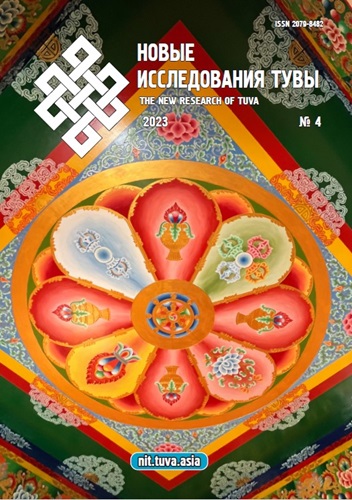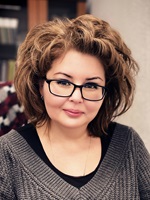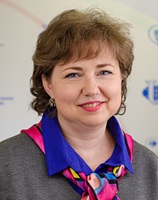The image of Tuva's space in Runet
DOI:
https://doi.org/10.25178/nit.2023.4.13Keywords:
Tuva; Republic of Tuva; space; internet text; functional-semantic approach; landscape semanticsAbstract
Each distinct region, both within Russia and globally, is primarily conceived as a territory — a space whose representation is crafted through diverse informational and communicative channels. The present article undertakes an analysis of creolized texts within the Russian-language segment of the internet pertaining to travel experiences in the Republic of Tuva from 2020 to 2023. The primary objective of this research is to delineate the verbal and non-verbal mechanisms employed in shaping the image of the Republic of Tuva as a distinctive region within Russia, within the context of polycode Russian-language internet texts on travel, encompassing genres such as blogs, posts, and websites. These texts are authored by individuals who share their impressions and emotions regarding their journeys to this particular region.
The research methodology is grounded in functional-semantic and structural-semantic approaches, facilitating a comprehensive analysis of empirical material and the identification of means employed in representing the image of Tuva, key linguistic units, and their associated semantics.
Throughout the course of the study, diverse creolized texts on travels to the Republic of Tuva were discerned within the Russian-language internet segment. These texts exhibit structural and semantic variances, encompassing travel reviews, blogger interviews, writings by professional travel journalists, impressionistic poetic compositions, and video sketches. In these works, the virtual representation of Tuva as a unique natural expanse is constructed through the utilization of lexical units imbued with landscape semantics, succinct grammatical-syntactic constructions, the establishment of associative series, and other verbal and non-verbal modalities (comprising audio and video elements, as well as photographic illustrations).
References
Abdulova, I. (2004) Virtual'naia Mongoliia: Internet-obraz prostranstva v irkutskom i buriatskom segmentakh Seti [Virtual Mongolia: The Internet image of space in the Irkutsk and Buryat segments of the Network]. Vestnik Evrazii, no. 3, pp. 9–25. (In Russ.).
Anisimov, V. E., Borisova, A. S. and Kalinnikova, E. D. (2022) Obrazy traditsionnoi i sovremennoi Tuvy v rossiiskom etnograficheskom kino (na primere fil'ma S. Rodninoi i A. Men'shova «Planeta Tyva») [Images of Traditional and Modern Tuva in Ethnographic Cinema (based on the film of S. Rodnina and A. Menshov “Tyva Planet”)]. New Research of Tuva, no. 1, pp. 183–197. (In Russ.). DOI: https://doi.org/10.25178/nit.2022.1.2
Arutiunova, N. D. (2003) Predlozhenie i ego smysl: Logiko-semanticheskie problem [Sentence and its meaning: Logical and semantic problems]. Moscow, Editorial URSS. 383 p. (In Russ.).
Bolotnova, N. S. (1992) Khudozhestvennyi tekst v kommunikativnom aspekte i kompleksnyi analiz edinits leksicheskogo urovnia [Literary text in the communicative aspect and complex analysis of lexical level units]. Tomsk, Tomsk University Publ. 309 p. (In Russ.).
Vol'f, E. M. (2006) Funktsional'naia semantika otsenki [Functional semantics of evaluation]. Moscow, KomKniga. 280 p. (In Russ.).
Golovkov, A. N. (2011) Prostranstvennoe razvitie kak ekonomicheskaia kategoriia [Spatial development as an economic category]. Upravlenie ekonomicheskimi sistemami, no. 2 (26), pp. 14–20. (In Russ.).
Golovnev, I. A. (2021) Obrazy Tuvy v sovetskom kinematografe 1930-kh gg. (na primere tvorchestva Borisa Nebylitskogo) [Images of Tuva in Soviet Cinema of the 1930s (The Case of Boris Nebylitsky’s Creativity)]. New Research of Tuva, no. 4, pp. 119–130. (In Russ.). DOI: https://doi.org/10.25178/nit.2021.4.9
Dibrova, E. I. (1999) Prostranstvo teksta v kompozitivnom chlenenii [Text space in compositive division]. In: Struktura i semantika khudozhestvennogo teksta [Structure and semantics of a literary text]: reports of the VII International Conference / ed. by E. A. Dibrov. Moscow, SportAkademPress. 479 p. Pp. 91–138. (In Russ.).
Zamiatin, D. N. (2006) Kul'tura i prostranstvo: Modelirovanie geograficheskikh obrazov [Culture and space: Modeling of geographical images]. Moscow, Znak. 488 p. (In Russ.).
Ivanova, M. V. and Klushina, N. I. (2021) Kreativnye vozmozhnosti iazyka v internet-kommunikatsii [Creative possibilities of language in Internet communication]. Vestnik Rossiiskogo fonda fundamental'nykh issledovanii. Gumanitarnye i obshchestvennye nauki, no. 1, pp. 52–62. (In Russ.). DOI: https://doi.org/10.22204/2587-8956-2021-103-01-52-62
Kazarin, Yu. V. (1999) Poeticheskii tekst kak Sistema [Poetic text as a system]. Ekaterinburg, Ural University Publ. 260 p. (In Russ.).
Kliushina, A. M. (2020) Problema bytovaniia funktsional'no-semanticheskogo podkhoda v lingvistike: sistematicheskii obzor [Functional-Semantic Approach Existence in Linguistics: Systematic Review]. Philology. Theory & Practice, vol. 13, issue 10, pp. 113–118. (In Russ.). DOI: https://doi.org/10.30853/filnauki.2020.10.21
Karruters, D. (2007) Nevedomaia Mongoliia. T. 1: Uriankhaiskii krai [Unknown Mongolia. Vol. 1: Urianhai region]. In: Uriankhai. Tyva depter [Urianhai. Tyva Depter]: an anthology: in 7 vol. / comp. by S. K. Shoigu. Moscow, Slovo. Vol. 4: Uriankhaiskii krai: perekrestok mnenii (konets XIX — nachalo XX v.). 549 c. S. 10–261. (In Russ.).
Kiseleva, L. A., Todosienko, Z. V., Lukmanova, R. R. and Kuular, E. M. (2022) Metafora kak sredstvo vizualizatsii ob’ekta naimenovaniia v mediatekstakh (na materiale russkogo, angliiskogo, tatarskogo i tuvinskogo iazykov) [Metaphor as a means of visualizing an object of naming in media texts (a case study of the Russian, English, Tatar and Tuvan languages)]. New Research of Tuva, no. 4, pp. 243–256 (In Russ.). DOI: https://www.doi.org/10.25178/nit.2022.4.18
Maksimenko, O. I. (2012) Polikodovyi vs. kreolizovannyi tekst: problema terminologii [Polycode vs. creolized text: the problem of terminology]. Vestnik Rossiiskogo universiteta druzhby narodov. Seriia: Teoriia iazyka. Semiotika, Semantika, no. 2, pp. 93–101. (In Russ.).
Kobzeva, E. V. (2017) Polikodovyi tekst kak ob"ekt filologicheskogo analiza [Polycode text as an object of philological analysis]. Izvestiia Volgogradskogo gosudarstvennogo pedagogicheskogo universiteta, no. 10 (123), pp. 58–62. (In Russ.).
Komutstsi, L. V. and Karpunina, I. V. (2021) Tekstovaia modal’nost’ kak sposob tsennostnogo predstavleniia Tuvy v nemetskoi publitsistike [Text Modality as a Mode of Value-based Representation of Tuva in German Opinion Journalism]. New Research of Tuva, no. 4, pp. 89–100. (In Russ.). DOI: https://doi.org/10.25178/nit.2021.4.7
Kreolizovannyi tekst: Smyslovoe vospriiatie [Creolized text: Semantic perception] (2020) / ed. by I. V. Vashunina. Moscow, Institut iazykoznaniia RAN. 206 p. (In Russ.).
Lamazhaa, Ch. K. (2018) Natsional'nyi kharakter tuvintsev [The national character of Tuvans]. Moscow, St. Petersburg, Nestor-Istoriia. 240 p. (In Russ.).
Lamazhaa, Ch. K. (2019) Geokul'turnye obrazy buddiiskogo mira tuvintsev: istoricheskii kontekst i sovremennost' [Geocultural images of the Tuvan Buddhist world: historical context and modernity]. New Research of Tuva, no. 3, pp. 27–40. (In Russ.). DOI: https://doi.org/10.25178/nit.2019.3.3
Levina, V. N. (2012) Peizazhnaia kartina mira v sisteme russkoi iazykovoi kul'tury [Landscape picture of the world in the system of Russian language culture]. Tambov, TROO «Biznes-Nauka-Obshchestvo». 260 p. (In Russ.).
Mal'kova, V. K. and Tishkov, V. A. (2009) Kul'tura i prostranstvo. Kniga pervaia. Obrazy rossiiskikh respublik v Internete [Culture and space. The first book. Images of Russian republics on the Internet]. Moscow, IEA RAN. 147 p. (In Russ.).
Mirzaeva, T. V. (2007) Polisemanticheskii potentsial slova voda v poezii Viacheslava Ivanova [Polysemantic potential of the word water in the poetry of Vyacheslav Ivanov]. Voprosy kognitivnoi lingvistiki, no. 3, pp. 119–126. (In Russ.).
Nikolina, N. A. (2009) Aktivnye protsessy v iazyke sovremennoi russkoi khudozhestvennoi literatury [Active processes in the language of modern Russian fiction]. Moscow, ITDGK «Gnozis». 336 s. (In Russ.).
Piskunova, S. V. (2002) Tainy poeticheskoi rechi (grammaticheskaia forma i semantika teksta) [Secrets of poetic speech (grammatical form and semantics of the text)]. Tambov, TGU Publ. 408 p. (In Russ.).
Popkov, Iu. V., Tiugashev, E. A. (2019) Prostranstvennyi obraz Tuvy v ob"ektive sotsiokul'turnoi fenomenologii [The spatial image of Tuva in the focus of sociocultural phenomenology]. New Research of Tuva, no. 3, pp. 4–14. (In Russ.). DOI: https://doi.org/10.25178/nit.2019.3.1
Sonin, A. G. (2005) Eksperimental'noe issledovanie polikodovykh tekstov: osnovnye napravleniia [Experimental study of polycode texts: main directions]. Voprosy iazykoznaniia, no. 6, pp. 115–123. (In Russ.).
Shestopal, E. B., Smul'kina N. V. And Sorozikova, I. V. (2019) Sravnitel'nyi analiz obrazov svoei strany u zhitelei rossiiskikh regionov [Comparative analysis of one’s own country images in Russian regions]. Sravnitel'naia politika i geopolitika, vol. 10, no. 3, pp. 74–94. (In Russ.). DOI: https://doi.org/10.24411/2221-3279-2019-10031
Shliakhova, D. A. (2017) Zhanrovye kharakteristiki blogov kak elektronnykh sredstv massovoi kommunikatsii [Genre features of blogs as electronic means of mass communication]. Vestnik RUDN. Seriia: Teoriia iazyka. Semiotika. Semantika, vol. 8, no. 4, pp. 939–948. (In Russ.). DOI: https://doi.org/10.22363/2313-2299-2017-8-4-939-948
Shumilina, S. A. and Levina, V. N. (2021) Implitsitnye sposoby vyrazheniia avtorskoi pozitsii v publitsisticheskom diskurse blogosfery Runeta [Implicit ways to express the author’s opinion in the publicistic discourse of Runet blogosphere]. Rusistika, vol. 19, no. 4, pp. 481–495. (In Russ.). DOI: http://dx.doi.org/10.22363/2618-8163-2021-19-4-481-495
Published
How to Cite
For citation:
Bragina M. A. and Levina V. N. Obraz prostranstva Tuvy v Runete [The image of Tuva’s space in Runet]. New Research of Tuva, 2023, no. 4, pp. 185-199. DOI: https://doi.org/10.25178/nit.2023.4.13
Issue
Section

This work is licensed under a Creative Commons Attribution-NonCommercial 4.0 International License.

Author(s) license holder(s) grant rights for their work to the journal (grantee of a license) under the simple non-exclusive open license in accordance with Art. 1286.1 «Open license for a research work, work of literature or fine arts», Civil Code of the Russian Federation.
New Research of Tuva publishes articles under the Creative Commons Attribution-NonCommercial license (CC BY-NC).
Since it is an open license, author(s) reserve the right to upload the article to their institutional repository, submit it to another journal (if it allows republications), or republish it on their own website (in full, or in part).
However, several conditions apply here:
a) The republished version must always contain the name(s) and affiliation(s) of the author(s), the original title and the hyperlink to the original version on the New Research of Tuva website;
b) It must be in open access, free of charge, and no category of readers must be in any way whatsoever advantaged over general readership.
c) should the contribution be submitted elsewhere by its author(s) without substantial modification (30% or more of original text unchanged), the body of the article should contain a disclaimer that the original version was published in New Research of Tuva (with a link to the respective page)
The CC-BY-NC is a non-revocable license which applies worldwide and lasts for the duration of the work’s copyright.










